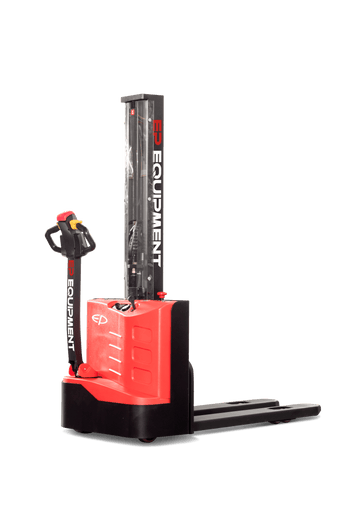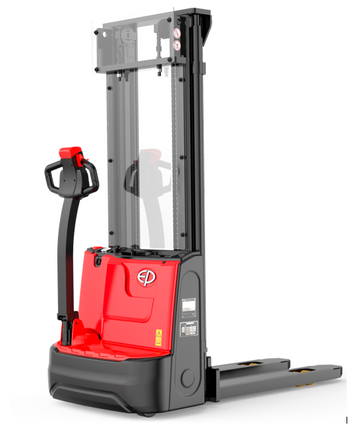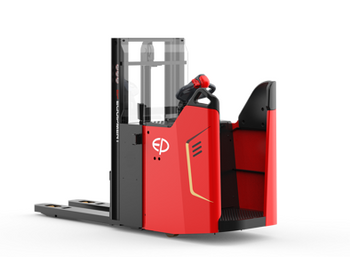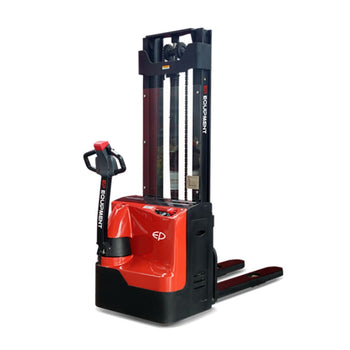Operating electric pallet stackers safely is critical for protecting staff and stock, maintaining productivity and complying with UK health‑and‑safety law. These battery‑powered machines are easier to manoeuvre than traditional fork‑lifts, but they still lift heavy loads and can cause injury if mishandled. The UK’s Provision and Use of Work Equipment Regulations 1998 (PUWER) require employers to ensure that anyone using equipment such as powered pallet trucks is adequately trained. The best way to protect people and goods is to combine proper training with strong safety habits and well‑designed equipment.
This guide outlines five actionable safety tips for operators and warehouse managers. Each section draws on best‑practice guidance from industry sources and highlights how iLift’s lithium‑ion pallet stackers support safe operation.
1. Conduct a thorough pre‑operation inspection
Before using an electric pallet stacker, the operator should perform a systematic inspection to make sure the equipment is safe. Industry guidance emphasises a pre‑operation inspection sheet for electric pallet jacks to confirm that the unit is in good working condition and to report any issues. Operators should:
-
Check safety devices and labels. Ensure that warning labels and data plates are legible and that emergency reverse controls and horns work.
-
Test all controls. Verify that the raising and lowering functions, forward and reverse controls, horn and brakes operate smoothly.
-
Examine wheels, forks and the chassis. Inspect wheels, tyres and forks for cracks, excessive wear or leaks; damage could cause unstable loads or sudden failures.
-
Assess battery charge and cables. A fully charged battery helps prevent mid‑task stoppages. Check that the battery is secure and free of corrosion and that cables and connectors are undamaged.
If the inspection reveals any defects, the equipment should be taken out of service until repaired. Documenting checks and reporting issues helps managers track maintenance and comply with PUWER record‑keeping requirements.
iLift’s electric pallet stackers simplify pre‑use checks. The ES12‑12ES entry‑level stacker includes an integrated charger and gel battery so there is no need to handle separate chargers. The ES16‑RS model has a high‑rigidity mast and strong chassis that promote stability, while the ES12‑12MM mono‑mast stacker is designed for height‑restricted areas and offers excellent visibility, reducing the risk of unseen damage during checks. Regular inspections combined with quality equipment are the first line of defence against accidents.
2. Provide comprehensive operator training and refresher courses
Electric pallet stackers may seem simple to drive, but they are classed as powered industrial trucks. Formal and hands‑on instruction is essential; operators should learn hazard recognition, safe driving, emergency procedures and battery handling. The AAA Forklifts guide stresses that proper training and certification are crucial for all operators and that refresher courses should be completed every three years. Certificates should be documented even though physical cards are not always required.
In the UK, training must cover health‑and‑safety law, the manufacturer’s manual, pre‑use inspections and practical operation in the specific workplace. Employers can deliver training internally or via external providers, and they should tailor courses to the types of pallet stackers on site. Hands‑on practice helps operators gain familiarity with features such as speed controllers, brake systems and load stability.
Refresher training is not just a legal formality; it keeps skills fresh and helps correct bad habits that develop over time. According to the CertifyMe article, training teaches users to identify risks, navigate warehouses and prevent accidents before they happen. In particular, operators learn to keep loads centred, maintain safe speeds and avoid pulling the equipment. Investing in quality training reduces accidents and downtime and signals a safety‑first culture.
iLift can assist by supplying user manuals and providing advice on training providers. Their ESL122 lithium‑ion stacker uses a maintenance‑free 24 V/80 Ah battery with a Battery Management System (BMS), so training on charging procedures is straightforward. In addition, the machine includes an abdominal safety button, smooth braking and speed adjustment (including a turtle mode that allows operation with the tiller upright), all of which operators should practise during training.

3. Use correct operating techniques
Even with a well‑maintained stacker and trained operator, risky behaviour can cause accidents. Safe operating techniques reduce strain and prevent collisions:
-
Push rather than pull. When moving a load, always push the pallet stacker. The AAA guide notes that pushing provides better control and reduces the risk of back strain. Pulling can make it harder to stop the machine quickly and encourages operators to walk backwards, increasing the chance of trips or crushed feet.
-
Maintain safe speeds and clear visibility. Operators should slow down before corners and look both ways. Mirrors or spotters can help in congested areas. Sudden turns, slopes and slippery floors are particularly hazardous for electric pallet jacks.
-
Keep limbs clear. Operators must avoid walking backward with feet under the forks and keep hands away from pinch points. Staying alert prevents crushed limbs.
-
Navigate inclines with care. Move slowly on slopes and keep the load stable; if the incline is steep, use another method. Never ride on the forks or platform.
-
Respect weight limits. Overloading shortens equipment life and increases the risk of tipping. Operators should know the rated capacity and refer to the data plate.
-
Follow site traffic rules. Use designated routes, yield to pedestrians and communicate with other operators using hand signals or radios.
Many accidents arise from complacency. The CertifyMe article warns against speeding and inattentive use; although electric pallet jacks move slowly, they can still injure people if the operator is distracted. Operators should avoid using mobile phones or wearing headphones while moving loads.
iLift designs its pallet stackers to support safe techniques. The ES16‑RS features a programmable speed limit and automatically lowers forks when the lift function is not in use. These functions encourage controlled driving and reduce the risk of collisions. The ES‑WA straddle arm series is equipped with easily adjustable arms and a powerful AC motor, allowing operators to handle pallets of different sizes safely and maintain precise control. In height‑restricted areas, the ES12‑12MM’s side‑operating design gives excellent visibility and reduces operator strain, making safe manoeuvring easier.
4. Maintain the battery and equipment properly
Electric pallet stackers rely on batteries and hydraulic systems; poor maintenance leads to unexpected stoppages and potential accidents. The AAA Forklifts guide emphasises regular battery maintenance to prevent downtime and accidents. Best practices include:
-
Charge fully before use. Ensure the battery is fully charged before starting work. A low charge can cause the stacker to stop mid‑task.
-
Inspect batteries regularly. Check for signs of wear or damage and ensure cables are intact and connectors secure.
-
Follow safe charging procedures. Charge the battery in a clean, well‑ventilated area free of flammable materials, following the manufacturer’s guidelines. Disconnect the battery or remove the key if the machine will be unattended to prevent unauthorised use.
-
Clean the machine. Keep the stacker free of dust and debris. Clean or replace filters and lubricate moving parts according to the service schedule.
-
Schedule regular service. Record maintenance activities and arrange periodic inspections by qualified technicians.
iLift’s lithium‑ion stackers simplify maintenance. The ES‑WA series includes easily adjustable straddle arms and components designed for straightforward servicing, while the ES12‑12ES comes with a gel battery and integrated charger so operators can recharge without removing the battery. Models such as the ES12‑12MM offer anti‑rolling braking devices to prevent the truck from moving unintentionally on inclines, reducing wear on brakes and tyres. The ESL122’s maintenance‑free lithium‑ion battery allows up to four hours of operation, and its BMS optimises battery life, simplifying care.
5. Handle loads and the environment safely
Proper load handling is central to safe pallet stacker operation. Key guidelines include:
-
Check load stability. Ensure that the load is secure and evenly distributed; unstable loads can tip over. Place heavier items on the bottom and lighter items on top to maintain balance.
-
Respect weight limits. Never exceed the rated capacity of the pallet stacker. Overloading can cause equipment failure and injuries.
-
Use the right attachment or straddle width. Adjustable straddle arms, like those on the ES‑WA series, allow operators to handle pallets of different sizes safely.
-
Park and store safely. When parking a pallet stacker, always lower the forks to the ground and ensure the machine is stable. Store the unit in its designated location away from pedestrian walkways.
-
Be aware of your environment. Watch for uneven floors and slopes; if the surface is rough, use equipment suitable for that terrain. The ES‑WA series is designed with durable wheels that allow it to move across uneven surfaces, whereas the ES16‑RS performs best on smooth surfaces.
-
Communicate and plan routes. Use hand signals or radios to coordinate with other operators when entering blind corners. Clearly marked pedestrian walkways and traffic zones improve safety.
Managers should also consider the warehouse layout. Clear aisles, good lighting and signage help operators maintain situational awareness. In high‑traffic areas, additional visibility aids such as mirrors or audible warning devices reduce the likelihood of collisions. Warehouse supervisors should monitor compliance and regularly review safety procedures.

Why choose iLift for safe electric pallet stackers?
iLift specialises in lithium‑ion material handling equipment and offers a range of electric pallet stackers that combine performance with robust safety features. Models in the ES‑ES and ES‑WA series use powerful 24 V AC motors and high‑capacity batteries (80 Ah–205 Ah) to deliver up to 3,000 mm lift height and capacities between 1,200 kg and 1,600 kg. The ES‑WA straddle arm stackers feature adjustable arms for non‑standard pallets and easy maintenance, while the ES12‑12MM mono‑mast stacker is designed for height‑restricted spaces and reduces operator strain with side operation. All machines come with integrated or maintenance‑free batteries, and safety features such as emergency stop buttons, automatic braking and speed control.
Unlike conventional forklifts, iLift’s stackers are compact and manoeuvrable, allowing operators to work confidently in narrow aisles. The ESL122 offers a cost‑effective alternative to a forklift; its high‑strength chassis and high‑rigidity mast provide excellent stability, and the maintenance‑free lithium‑ion battery can operate for up to four hours on a single charge. For heavier workloads, the ES16‑RS delivers 1,600 kg capacity with programmable speed limits and automatic lowering of forks, promoting safe, efficient lifting. Whichever model you choose, iLift supplies pre‑delivery inspections, flexible service contracts and a five‑year battery warranty, giving you peace of mind and minimising downtime.
Ready to improve warehouse safety?
Keeping warehouse staff safe starts with the right equipment and training. iLift’s electric pallet stackers combine advanced lithium‑ion technology with operator‑friendly features like adjustable straddle arms, ergonomic tillers and comprehensive safety systems. Contact iLift today on 01600 800 800 or email enquiry@ilift.co.uk to discuss your material handling needs, arrange a demonstration or enquire about training support. You can explore the full range of pallet stackers and download model specifications by visiting . Investing in safe, reliable equipment and comprehensive training will protect your staff, improve efficiency and demonstrate your commitment to safety.





